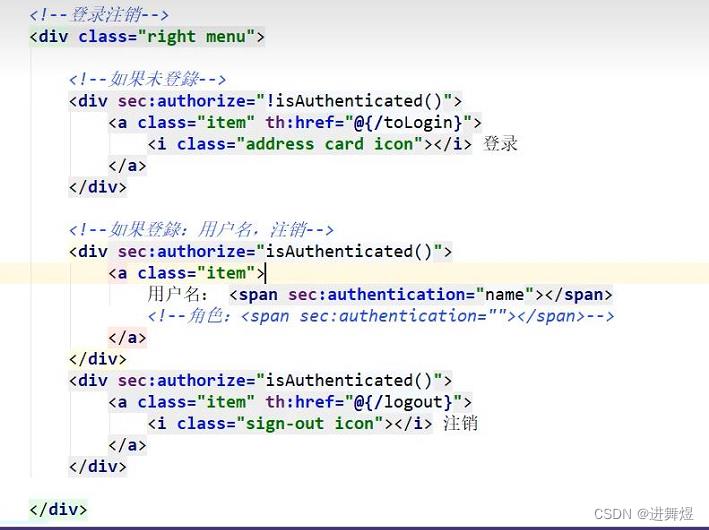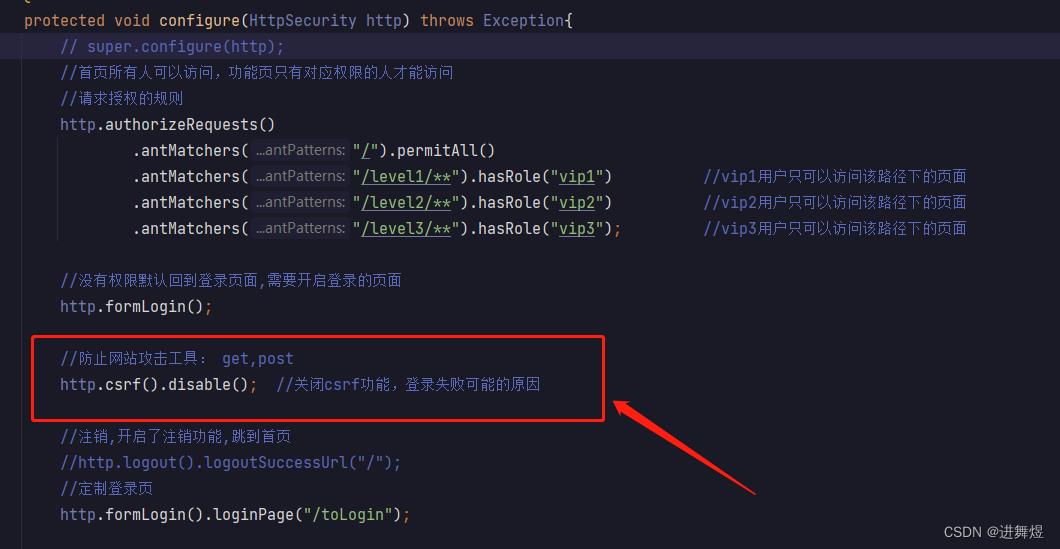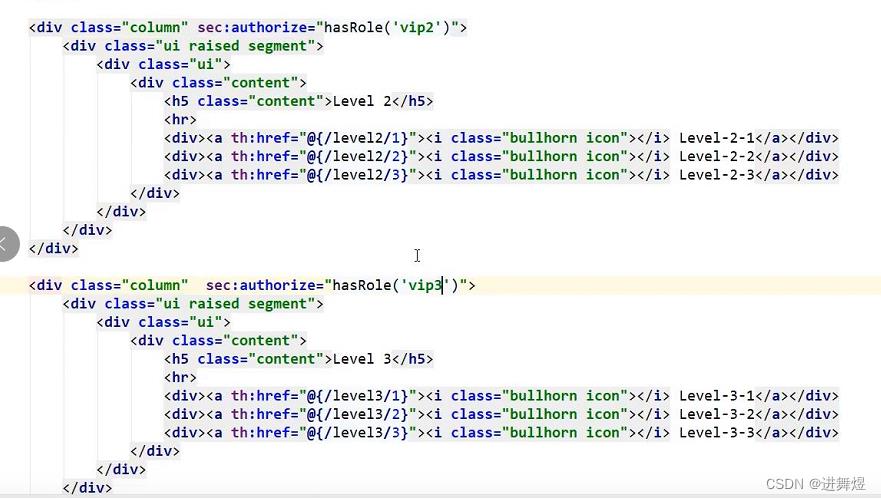SpringSecurity的配置
Posted 进舞煜
tags:
篇首语:本文由小常识网(cha138.com)小编为大家整理,主要介绍了SpringSecurity的配置相关的知识,希望对你有一定的参考价值。
一、SpringSecurity的功能简单介绍
(1)简介
SpringSecurity是针对Spring项目的安全框架,也是Spring Boot底层安全模块默认的技术选型,他可以实现强大的Web安全控制,对于安全控制,我们仅需要引入spring-boot-starter-security模块,进行少量的配置,即可实现强大的安全管理!
主要的几个类:
webSecurityConfigurerAdapter:自定义Security策略
AuthenticationManagerBuilder:自定义的认证策略
@EnableWebSecurity:开启WebSecurity模式
SpringSecurity的两个主要目标是"认证”和“授权”(访问控制)。
“认证”(Authentication)
“授权”(Authorization)
(2)SpringSecurity的主要功能
1.功能权限
2.访问权限
3.菜单权限
4.拦截器,过滤器
5.AOP:横切 配置类
二.SpringSecurity的使用
1.引入Spring Security的依赖包
<dependency>
<groupId>org.springframework.boot</groupId>
<artifactId>spring-boot-starter-security</artifactId>
</dependency>2.配置SecurityConfig类
//AOP : 拦截器
@EnableWebSecurity
public class SecurityConfig extends WebSecurityConfigurerAdapter
//链式编程
@Override
protected void configure(HttpSecurity http) throws Exception
// super.configure(http);
//首页所有人可以访问,功能页只有对应权限的人才能访问
//请求授权的规则
http.authorizeRequests()
.antMatchers("/").permitAll()
.antMatchers("/level1/**").hasRole("vip1") //vip1用户只可以访问该路径下的页面
.antMatchers("/level2/**").hasRole("vip2") //vip2用户只可以访问该路径下的页面
.antMatchers("/level3/**").hasRole("vip3"); //vip3用户只可以访问该路径下的页面
//没有权限默认回到登录页面,需要开启登录的页面
http.formLogin();
//注销,开启了注销功能,跳到首页
//http.logout().logoutSuccessUrl("/");
//定制登录页
http.formLogin().loginPage("/toLogin");
//开启记住我功能 cooke
http.rememberMe();
//认证 springboot 2.1.X 可以直接使用
//密码编码: passwordEncoder
//在spring Security 5.0+ 新增了很多的加密方法
@Override
protected void configure(AuthenticationManagerBuilder auth) throws Exception
//这些数据正常应该从数据库中读取 现在测试的是从内存中读取的数据
auth.inMemoryAuthentication().passwordEncoder(new BCryptPasswordEncoder()) //加了一个密码的编码规则
.withUser("LJ").password(new BCryptPasswordEncoder().encode("123")).roles("vip2","vip3")
.and()
.withUser("root").password(new BCryptPasswordEncoder().encode("123")).roles("vip1","vip2","vip3")
.and()
.withUser("guest").password(new BCryptPasswordEncoder().encode("123")).roles("vip1");
//从数据库中获取数据
// auth.jdbcAuthentication()
// .dataSource(dataSource)
// .withDefaultSchema()
// .withUser(users.username("user").password("password").roles("USER"))
// .withUser(users.username("admin").password("password").roles("USER","ADMIN"));
三.前端使用SpringSecurity
1.前端使用thymeleaf框架
(1)引入thymeleaf模板的依赖
<!-- thymeleaf模板 -->
<dependency>
<groupId>org.thymeleaf</groupId>
<artifactId>thymeleaf-spring5</artifactId>
</dependency>
<dependency>
<groupId>org.thymeleaf.extras</groupId>
<artifactId>thymeleaf-extras-java8time</artifactId>
</dependency>(2)引入security-thymeleaf整合包
<!-- security-thymeleaf整合包 -->
<dependency>
<groupId>org.thymeleaf.extras</groupId>
<artifactId>thymeleaf-extras-springsecurity4</artifactId>
<version>3.0.4.RELEASE</version>
</dependency>(3)前端页面引入semantic-ui的框架包
2.前端页面用户用户认证和授权

如果注销失败:可能的原因是默认开启的csrf的防止网站攻击工具,可以在SecurityConfig中的加入关闭csrf:

根据登入的人的不同权限,会显示与对应权限的内容。


以上是关于SpringSecurity的配置的主要内容,如果未能解决你的问题,请参考以下文章